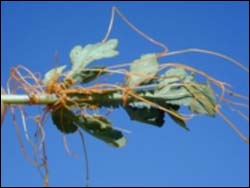Gene exchange between species is aided by parasitism

Parasitic dodder (genus Cuscuta) growing on a plant host. Mark S. Brunell
Gene exchange between different plant species is made possible by their parasites, according to an Indiana University Bloomington report in this week’s Nature.
IUB biologists’ discovery that genes can move from plant parasites to plant hosts complements a report by University of Michigan and Smithsonian Institution scientists in the July 30 issue of Science that showed the opposite — that genes can move from plant hosts to plant parasites. Taken together, the findings establish plant parasitism as the first known medium for “horizontal gene transfer,” the exchange of genes between individuals of different species.
“Plant parasitism has emerged as the first solid mechanism of horizontal transfer in plants,” said IUB biologist Jeff Mower, the Nature report’s lead author. “Other mechanisms also are likely to be important but, as of yet, they remain in the realm of speculation.”
In their report, Mower, Distinguished Professor of Biology Jeff Palmer, postdoctoral fellow Sasa Stefanovic and graduate student Gregory Young report two new examples of horizontal transfer of the important mitochondrial gene atp1 from parasitic flowering plants to weeds in the genus Plantago. Three Plantago species possess both a normal, functioning copy of atp1 and a second defective atp1 that bears a striking resemblance to the atp1 gene found in parasitic “dodders” in the plant genus Cuscuta. Evidence suggests Plantago weeds acquired the defective atp1 through horizontal transfer recently — not more than a few million years ago.
The dodders’ manner of attacking plants suggests a way DNA could have traveled between parasite and host, the IU scientists say. As part of their parasitism, dodder cells penetrate the cells of their hosts, making it possible for errant parasite DNA to sidestep several obstacles on its way into a host cell.
Media Contact
More Information:
http://www.indiana.eduAll latest news from the category: Life Sciences and Chemistry
Articles and reports from the Life Sciences and chemistry area deal with applied and basic research into modern biology, chemistry and human medicine.
Valuable information can be found on a range of life sciences fields including bacteriology, biochemistry, bionics, bioinformatics, biophysics, biotechnology, genetics, geobotany, human biology, marine biology, microbiology, molecular biology, cellular biology, zoology, bioinorganic chemistry, microchemistry and environmental chemistry.
Newest articles

High-energy-density aqueous battery based on halogen multi-electron transfer
Traditional non-aqueous lithium-ion batteries have a high energy density, but their safety is compromised due to the flammable organic electrolytes they utilize. Aqueous batteries use water as the solvent for…

First-ever combined heart pump and pig kidney transplant
…gives new hope to patient with terminal illness. Surgeons at NYU Langone Health performed the first-ever combined mechanical heart pump and gene-edited pig kidney transplant surgery in a 54-year-old woman…

Biophysics: Testing how well biomarkers work
LMU researchers have developed a method to determine how reliably target proteins can be labeled using super-resolution fluorescence microscopy. Modern microscopy techniques make it possible to examine the inner workings…





















